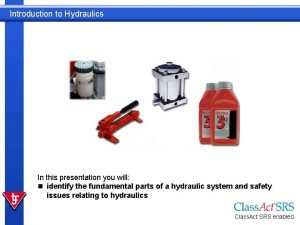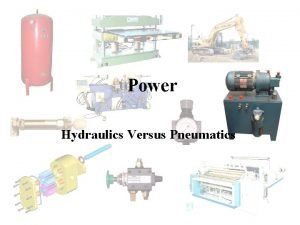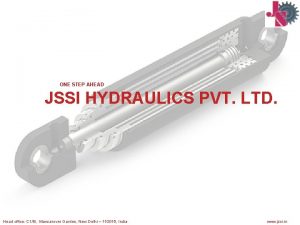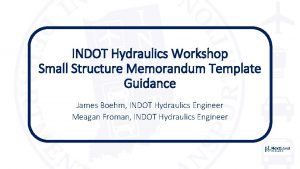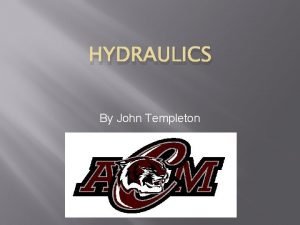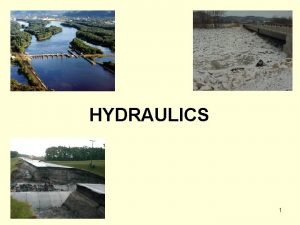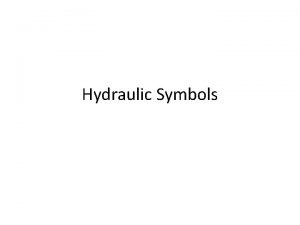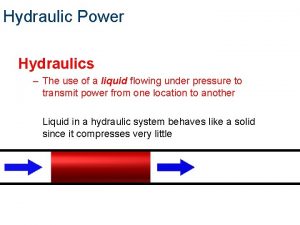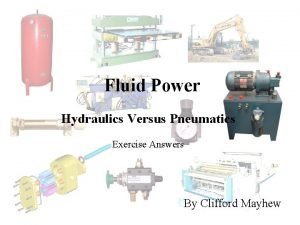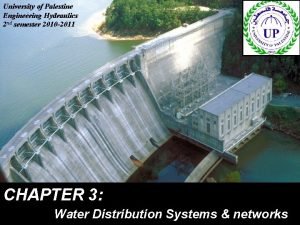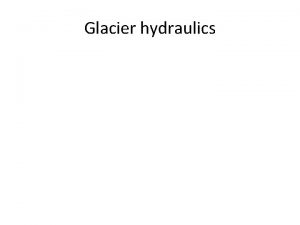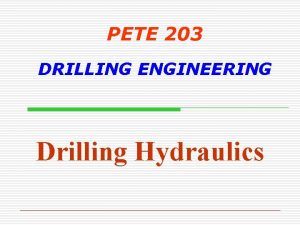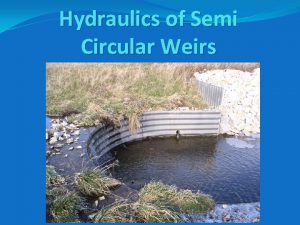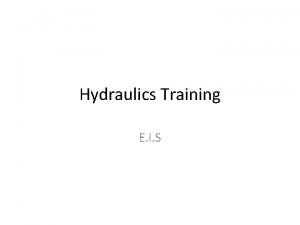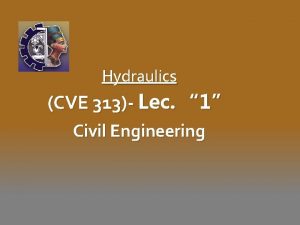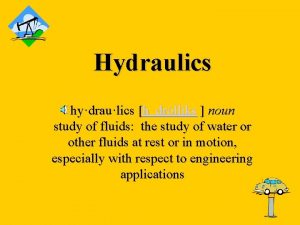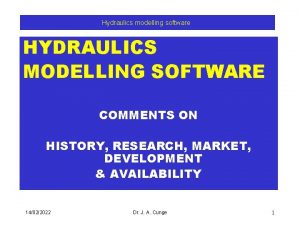Introduction to Hydraulics In this presentation you will













- Slides: 13

Introduction to Hydraulics In this presentation you will: n identify the fundamental parts of a hydraulic system and safety issues relating to hydraulics Class. Act SRS enabled.

Introduction to Hydraulics In this presentation you will see what hydraulic systems are. You will explore some of the safety issues associated with hydraulic systems and the fluids used in them. Next >

Introduction to Hydraulics Components of Hydraulic Systems All industrial hydraulic systems will have: n A fluid, usually oil. n A tank, or reservoir, to hold a supply of the fluid. n A pump to cause the fluid to flow. n An electric motor, or engine, to drive the pump. n Hoses or tubing to carry the fluid. n Valves to control fluid flow, direction and pressure. n One or more actuators, usually cylinders or hydraulic motors, to do the work where mechanical movement occurs. Next >

Introduction to Hydraulics Question 1 Two engineers are discussing the components required to make an industrial hydraulic system. Engineer A says a reservoir is needed to hold a supply of fluid. Engineer B says a motor driven pump is needed to cause the fluid to flow. Who is correct? A) Only engineer A B) Only engineer B C) Both engineer A and B D) Neither engineer A or B

Introduction to Hydraulics Compression of Fluids Two cylinders are shown. One cylinder contains a gas and the other contains a liquid. If a downward force is applied to the piston in the gas cylinder, the piston will move down and compress the gas. If a downward force is applied to the piston in the liquid cylinder, the piston will not move. Hydraulic cylinders use liquid, which is incompressible. Closed cylinder containing air (gas) Closed cylinder containing hydraulic fluid (liquid) Next >

Introduction to Hydraulics Hydraulic Fluids The primary purpose of hydraulic fluid is to transmit force from one place to another. However, hydraulic fluids are also required to: n Lubricate contact surfaces within the system. n Provide sealing of components, where tight clearances are involved. n Remove heat generated within the system. n Protect system components against rust, oxidation and corrosion. n Prevent foaming when subjected to turbulence. Next >

Introduction to Hydraulics When selecting a hydraulic fluid for an application, consideration must be given to the pressure, temperature and materials of the system. Improper selection can lead to: n Inadequate system performance. n Premature failure of components. n The potential for fire. n Environmental pollution in the event of loss of containment. Next >

Introduction to Hydraulics The main types of hydraulic fluid are: Petroleum based fluids: Most common type of fluid. Synthetic fire resistant fluids: Used where fire hazards or environmental pollution are a concern. Water based fire resistant fluids: Used where fire hazards or environmental pollution are a concern. Next >

Introduction to Hydraulics Hydraulic Fluid Safety Generally, hydraulic fluid: n Can cause skin and eye irritation. n Can cause medical problems. If ingested; seek medical attention immediately. n May cause medical problems, if repeatedly inhaled. n May be corrosive. n Must be disposed of according to Environmental regulations. Next >

Introduction to Hydraulics Question 2 Which of the following is NOT a function of hydraulic fluid? A) To cool system components B) To lubricate system components C) To protect against corrosion D) To expand seal components

Introduction to Hydraulics Hydraulic Systems Safety Here are some general safety procedures for working on hydraulic systems: n Always wear eye protection and appropriate clothing. n Never service the system while the pump is running (unless bleeding the system). n Do not remove cylinders until the working units are resting on the floor or ground, on safety stands or on blocks. n Before disconnecting oil lines, relieve all hydraulic pressure and discharge the accumulator. n Ensure that all line connections are tight and the lines are not damaged. Escaping oil under pressure is a fire hazard and can penetrate the skin causing serious injury. Next >

Introduction to Hydraulics Question 3 Which of the following tasks can be worked on, while the hydraulic pump is running? A) Removing cylinders B) Bleeding the system C) Disconnecting lines D) Servicing the system

Introduction to Hydraulics Summary You should now be aware of: n The fundamental parts of hydraulic systems n Hydraulic fluid n How to work safely with hydraulic systems End >
 Introduction to hydraulics and pneumatics
Introduction to hydraulics and pneumatics Hydraulics and pneumatics
Hydraulics and pneumatics Hydraulics and pneumatics symbols
Hydraulics and pneumatics symbols Jssi hydraulics
Jssi hydraulics Indot design memo
Indot design memo Hydraulics definition
Hydraulics definition Hydraulics definition
Hydraulics definition Single acting cylinder symbol
Single acting cylinder symbol Hydraulics and pneumatics
Hydraulics and pneumatics Pneumatics vs hydraulics
Pneumatics vs hydraulics Pneumatic telemetry system
Pneumatic telemetry system Hydraulics
Hydraulics Hydraulics exercise
Hydraulics exercise Palestine hydraulics
Palestine hydraulics
